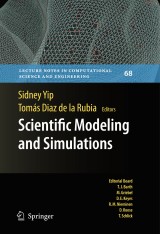Details

Scientific Modeling and Simulations
Lecture Notes in Computational Science and Engineering, Band 68
|
96,29 € |
|
| Verlag: | Springer |
| Format: | |
| Veröffentl.: | 07.04.2010 |
| ISBN/EAN: | 9781402097416 |
| Sprache: | englisch |
| Anzahl Seiten: | 402 |
Dieses eBook enthält ein Wasserzeichen.
Beschreibungen
Although computational modeling and simulation of material deformation was initiated with the study of structurally simple materials and inert environments, there is an increasing demand for predictive simulation of more realistic material structure and physical conditions. In particular, it is recognized that applied mechanical force can plausibly alter chemical reactions inside materials or at material interfaces, though the fundamental reasons for this chemomechanical coupling are studied in a material-speci c manner. Atomistic-level s- ulations can provide insight into the unit processes that facilitate kinetic reactions within complex materials, but the typical nanosecond timescales of such simulations are in contrast to the second-scale to hour-scale timescales of experimentally accessible or technologically relevant timescales. Further, in complex materials these key unit processes are “rare events” due to the high energy barriers associated with those processes. Examples of such rare events include unbinding between two proteins that tether biological cells to extracellular materials [1], unfolding of complex polymers, stiffness and bond breaking in amorphous glass bers and gels [2], and diffusive hops of point defects within crystalline alloys [3].
Scientific Modeling and Simulations.- A retrospective on the journal of computer-aided materials design (JCAD), 1993–2007.- Extrapolative procedures in modelling and simulations: the role of instabilities.- Characteristic quantities and dimensional analysis.- Accuracy of models.- Multiscale simulations of complex systems: computation meets reality.- Chemomechanics of complex materials: challenges and opportunities in predictive kinetic timescales.- Tight-binding Hamiltonian from first-principles calculations.- Atomistic simulation studies of complex carbon and silicon systems using environment-dependent tight-binding potentials.- First-principles modeling of lattice defects: advancing our insight into the structure-properties relationship of ice.- Direct comparison between experiments and computations at the atomic length scale: a case study of graphene.- Shocked materials at the intersection of experiment and simulation.- Calculations of free energy barriers for local mechanisms of hydrogen diffusion in alanates.- Concurrent design of hierarchical materials and structures.- Enthalpy landscapes and the glass transition.- Advanced modulation formats for fiber optic communication systems.- Computational challenges in the search for and production of hydrocarbons.- Microscopic mechanics of biomolecules in living cells.- Enveloped viruses understood via multiscale simulation: computer-aided vaccine design.- Computational modeling of brain tumors: discrete, continuum or hybrid?.
<P>The conceptualization of a problem (modeling) and the computational solution of this problem (simulation), is the foundation of Computational Science. This coupled endeavor is unique in several respects. It allows practically any complex system to be analyzed with predictive capability by invoking the multiscale paradigm—linking unit-process models at lower length (or time) scales where fundamental principles have been established to calculations at the system level. </P>
<P>The community of multiscale materials modeling has evolved into a multidisciplinary group with a number of identified problem areas of interest. Sidney Yip and Tomas Diaz De La Rubia, the editors of this volume, have gathered 18 contributions that showcase the conceptual advantages of modeling which, coupled with the unprecedented computing power through simulations, allow scientists to tackle the formibable problems of our society, such as the search for hydrocarbons, understanding the structure of a virus, or the intersection between simulations and real data in extreme environments. </P>
<P></P>
<P>Scientific Modeling and Simulations advocates the scientific virtues of modeling and simulation, and also encourages the cross fertilization between communities, exploitations of high-performance computing, and experiment-simulation synergies.</P>
<P>The contents of this book were previously published in <EM>Scientific Modeling and Simulations</EM>, Vol 15, No. 1-3, 2008.</P>
<P>The community of multiscale materials modeling has evolved into a multidisciplinary group with a number of identified problem areas of interest. Sidney Yip and Tomas Diaz De La Rubia, the editors of this volume, have gathered 18 contributions that showcase the conceptual advantages of modeling which, coupled with the unprecedented computing power through simulations, allow scientists to tackle the formibable problems of our society, such as the search for hydrocarbons, understanding the structure of a virus, or the intersection between simulations and real data in extreme environments. </P>
<P></P>
<P>Scientific Modeling and Simulations advocates the scientific virtues of modeling and simulation, and also encourages the cross fertilization between communities, exploitations of high-performance computing, and experiment-simulation synergies.</P>
<P>The contents of this book were previously published in <EM>Scientific Modeling and Simulations</EM>, Vol 15, No. 1-3, 2008.</P>
Showcases cutting-edge applications of modeling and computations to formidable research problems relevant to our society. Highlights the benefits of cross-fertilization between computational science and other research communities. Includes supplementary material: sn.pub/extras

















